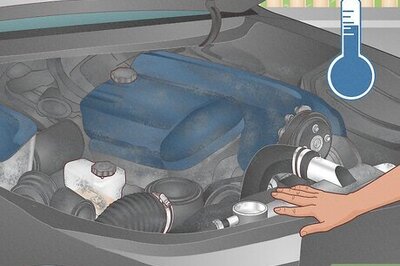
views
The Indian Air Force dropped multiple 1,000 kg bombs on Jaish-e-Mohammed terror camps across the Line of Control (LoC). For this 12 Indian Air Force Mirage-2000 fighter jets, made by Dassault Aviation, the French company who also manufactures the Rafale Medium Multi-Role Combat Aircrafts were used. Reports suggest that during this operation, Netra AEW&C and Heron drones kept an eye on possible retaliation by the Pakistan Air Force jets. Drones are becoming serious business in India, both in the commercial and military spheres These days airstrike’s on Syria and other IS affected areas are partly done by UAVs, which works as an observer, attacker and even in planning too. Armed drones have given India the option of taking out large terrorist camps or individual targets in hostile territory with minimal risk.
Heron:
The IAI Heron (Machatz-1) is a medium-altitude long-endurance unmanned aerial vehicle (UAV) developed by the Malat (UAV) division of Israel Aerospace Industries. It is capable of Medium Altitude Long Endurance (MALE) operations of up to 52 hours' duration at up to 10.5 km (35,000 ft). The Heron navigates using an internal GPS navigation device, and either a pre-programmed flight profile (in which case the system is fully autonomous from takeoff to landing), manual override from a ground control station, or a combination of both. It can autonomously return to base and land in case of lost communication with the ground station. The system has fully automatic launch and recovery (ALR) and all-weather capabilities.
Harpy:
Another product of Israel, it is used by Indian armed forces. It can carry explosive as well as can destroy radar system. The Harpy is designed to attack radar systems and is optimised for the SEAD role. It carries a high explosive warhead. The Harpy has been sold to several foreign nations, including South Korea, Turkey, India, and China.
AEW&C:
Airborne early warning and control (AEW&C) system is a multisensor developed by DRDO on a carrier jet which provides an airborne surveillance system in collaboration with CAB (Centre for Airborne Systems) for the Indian Air Force. It is the first native AEW system developed by DRDO and CAB. It was completely developed and built using the native technology platform, EMB-145. Mission system control (MSC) is the brain of the AEW&C system, as it incorporates all the data from sensors and other systems to control the whole system. It assesses threats using data received from the on-board sensors and other sources, and presents the Air Situation Picture (ASP).
Nishant:
The DRDO Nishant is an Unmanned Aerial Vehicle (UAV) developed by India's ADE (Aeronautical Development Establishment), a branch of DRDO (Defence Research and Development Organisation) for the Indian Armed Forces. The Nishant UAV is primarily tasked with intelligence gathering over enemy territory and also for reconnaissance, training, surveillance, target designation, artillery fire correction, damage assessment, ELINT and SIGINT. The UAV has an endurance of four hours and thirty minutes. Nishant has completed development phase and user trials.
Rustom:
It is an unnamed combat air vehicle, a production of DRDO dedicated to all three services of Indian armed forces. The project is under progress and some top private players in the defence field are bidding for its manufacturing deal. This UAV has come with wheels which makes its take-off and landing a bit ahead of Nishant.


















Comments
0 comment